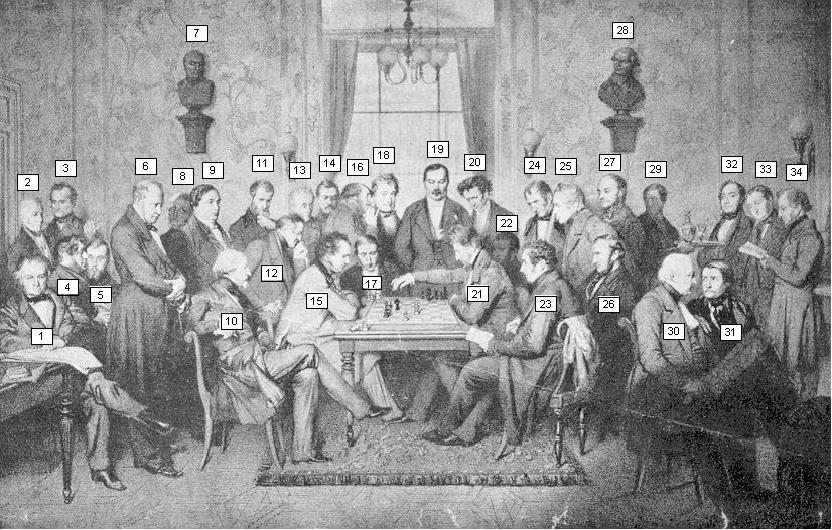
Edward Winter
ONE:
In C.N. 4259 Gene Gnandt (Houston, TX, USA) raised the subject of the 1843 illustration of Staunton v Saint Amant, which has been widely published (e.g. as a supplement to the November 1911 issue of La Stratégie). Noting that a key was given on pages 325-326 of volume two of Geschichte und Litteratur des Schachspiels by A. van der Linde (Berlin, 1874), our correspondent added numbers in the reproduction below:

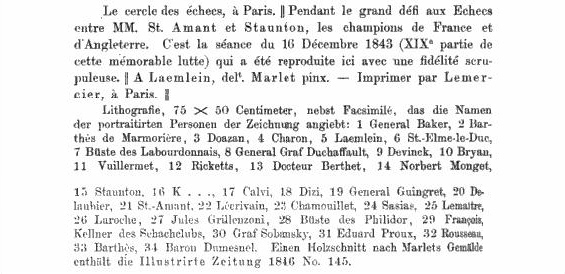
Mr Gnandt commented:
‘At least two of the figures are inconsistent with the key: “General Graf Duchaffault” (8) appears to the left of the “Büste des Labourdonnais” (7) while “Delaubier” (20) is clearly to the right of “St.-Amant” (21). These inconsistencies make me wonder about the correctness of the key as a whole. Can anyone confirm the identities of all the figures?’
We added that when the picture was given as the frontispiece to the February 1899 BCM ‘J.A.L.’ wrote on page 49 of that issue:
‘The original painting, after which the engraving was produced, is by Marlet, and in connection with it it is curious to note that its publication by the Palamède led to a lawsuit, in which St Amant was involved in his capacity of editor of that celebrated chess periodical. It appears that St Amant bought the painting of the artist for 500 francs, and handed it over to the engraver, Laemlein. The latter did not engrave from the original, but in the first instance made a copy of the painting, in which he substituted several well-known characters in the chess world for some of the persons in the original. As a consequence of these alterations, St Amant considered he was dealing with a fresh picture, and on publication he therefore only suffixed the name of the engraver. Thereupon Marlet brought an action against the Palamède for publishing his picture without his consent, and likewise for damages for the omission of his name. The first part of the action was dismissed, as it was held that the artist, in selling his picture, ceded all his rights to the purchaser. For the omission of his name he was awarded 200 francs damages, and St Amant was ordered to have Marlet’s name added to all future copies.’
For further details about the painting, and a reference to a slightly different key, see C.N. 5395, which provides a link to information we received from Etienne Cornil (Brussels).
See also an article on the Café de la Régence website.
TWO:
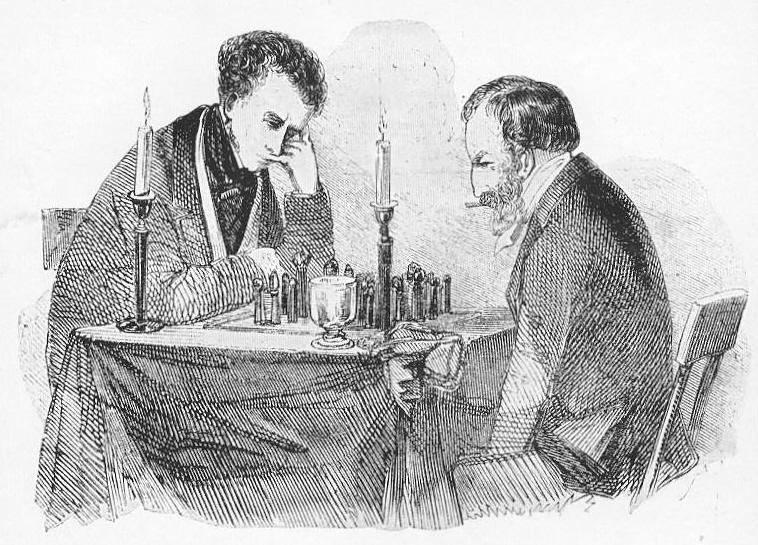
Howard Staunton and Bernhard Horwitz
Information is sought regarding the origins of this illustration, which was a Beilage in the 2 October 1910 issue of Deutsches Wochenschach.
THREE:
C.N. 5990 gave this well-known shot from the Leamington meeting of 1855: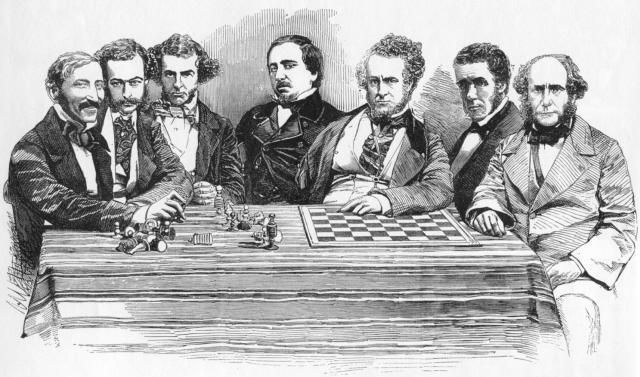
In C.N. 5976 Michael Clapham (Ipswich, England) provided from his collection this tinted version:
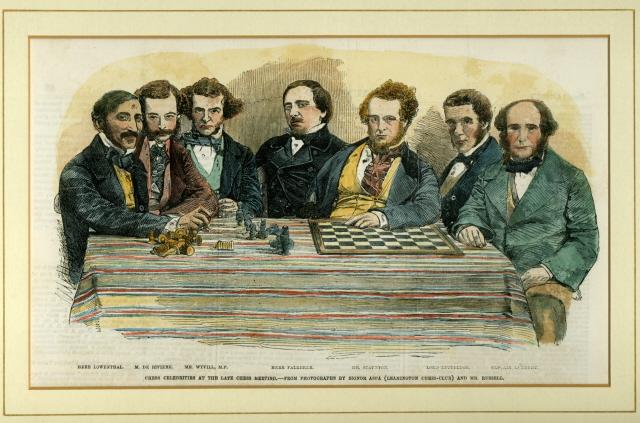
Mr Clapham also reported that page 166 of The Chess-Player’s Annual for 1856 edited by Charles Tomlinson (London, 1856) mentioned photographs taken by Rosario Aspa at Leamington:
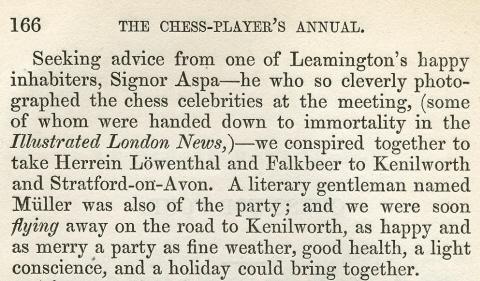
The picture, with a caption and a credit to the 1855 Illustrated London News, was published as the frontispiece to the August 1926 BCM.
Paul Dorion (Montreal, Canada) noted in C.N. 5990 the close similarities in the portrayal of Staunton (third from the right) and the picture of him which is given below as illustration Four. The two illustrations appeared on pages 22 and 24 respectively of Fred Wilson’s A Picture History of Chess (New York, 1981).
C.N. 8705 pointed out that when the picture was given on page 85 of The World of Chess by Anthony Saidy and Norman Lessing (New York, 1974) the players were not identified, and the reader was merely informed:
‘Staunton (third from right) among cronies.’
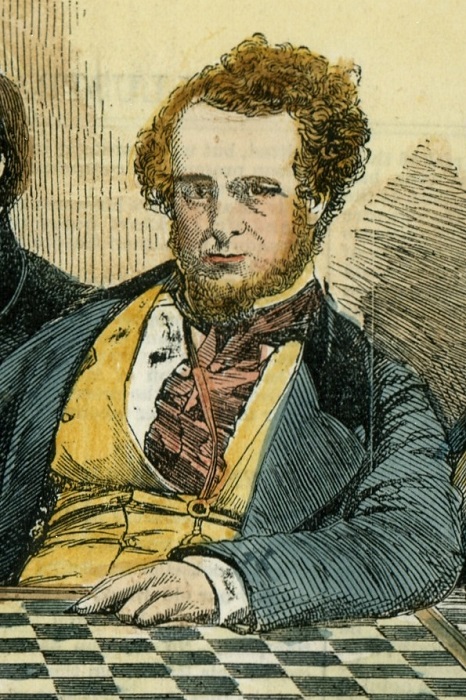
Howard Staunton
FOUR:
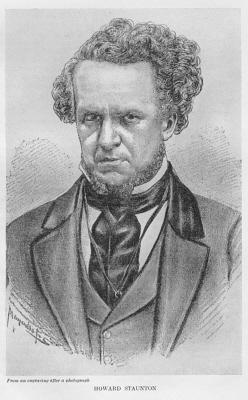
Regarding the above picture, another correspondent, John Townsend (Wokingham, England), noted in C.N. 5998 that it appeared opposite page 164 of A Century of British Chess by P.W. Sergeant (London, 1934) with the reference ‘From an engraving after a photograph’. Mr Townsend also commented:
‘The name in the bottom left-hand corner is hard to read; the first word may be something like “Maguille”.’
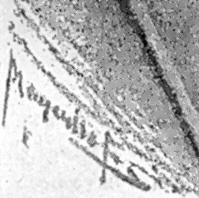
The illustration had been given on page 193 of the March 1890 Chess Monthly, and the following month (page 225) there was a portrait of Emanuel Lasker with the same signature. A similar sketch, though from the twentieth century, was by Alexander Forrest and appeared on page 70 of The Chess-player’s Week-end Book by R.N. Coles (London, 1950).
FIVE:
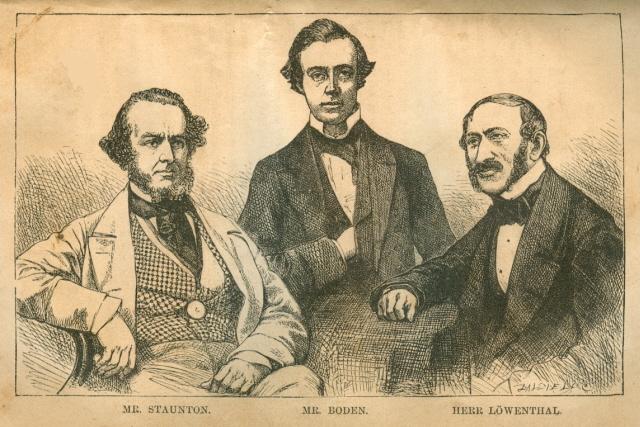
From opposite page 96 of the 1859
US edition of F.M. Edge’s book on Morphy
In C.N. 5958 Gene Gnandt (Houston, TX, USA) wrote:
‘On pages v-vi of his Preface to The Exploits and Triumphs, in Europe, of Paul Morphy, The Chess Champion (New York, 1859) Frederick M. Edge gave sources for the sketches in his book:
“The cuts with which this work is embellished have been engraved by the well-known Brothers Dalziel ...
The portraits of Messrs Staunton, Boden, Anderssen and Löwenthal are copies of photographs, for which they sat at the Manchester Meeting, in 1857.”
The photographs themselves, therefore, may have gone unpublished.
The earliest reference to photographs of masters that I was able to find comes with regard to a well-known sketch which appeared on page 44 of the Illustrated London News, 14 July 1855. Over 40 years later, Rosario Aspa wrote a letter to the BCM (August 1896, pages 331-332) about Marmaduke Wyvill. He remarked in part:
“In those days I had already become an ardent amateur photographer and, needless to say, I did not let this opportunity go by of securing portraits of so many great chessplayers. A week or two after the meeting, the Illustrated London News gave in woodcuts from my negatives the six players of the match just described, Lord Lyttelton, the president of the meeting, sitting in their midst. I have been told that the portrait of Staunton is the only one known, and in the group Mr Marmaduke Wyvill will be found sitting at his right hand.”’
We wondered whether it was known what became of Aspa’s archives (his obituary on page 231 of the June 1905 BCM reported that he died in Leamington), and in C.N. 5979 Tim Harding (Dublin) wrote:
‘... his scrapbooks are in the John G. White Collection in Cleveland under the following references:
“ASPA, ROSARIO
Chess articles, games, problems and game endings by Rosario Aspa; collected from his papers and arranged by John G. White. 789.32M AS61C2
Chess miscellanies: games, problems and game endings. Q 789.31 O1A V.1 AND V2.”’
Finally, it may be added that the illustration of Staunton alone was given opposite page 465 of the November 1908 BCM and as the Beilage in the 3 July 1910 issue of Deutsches Wochenschach:
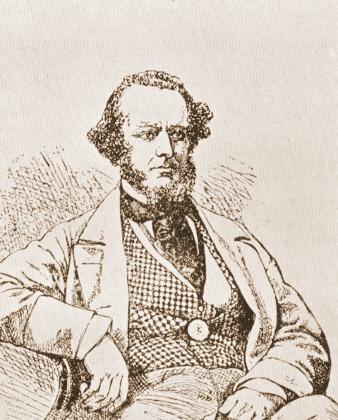
SIX:
Gordon Cadden (Newport, Wales) asks whether New York, 1857 (see C.N.s 3828 and 4780) is the first occasion when identifiable chess masters (e.g. Morphy and Paulsen) were photographed.
We can think of no earlier case but wonder whether the picture below of Staunton has been authoritatively dated, with firm information on its provenance. It became well known after appearing on page 102 of David Lawson’s 1976 monograph on Morphy.
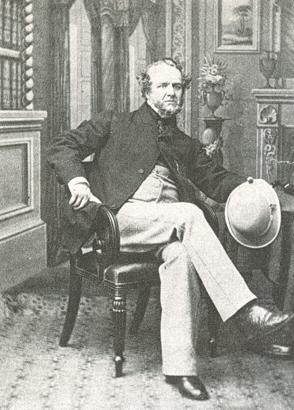
(5942)
A detail of the above photograph had appeared on page 56 of the January-February 1964 issue of Chessworld (to which Lawson was a contributor):
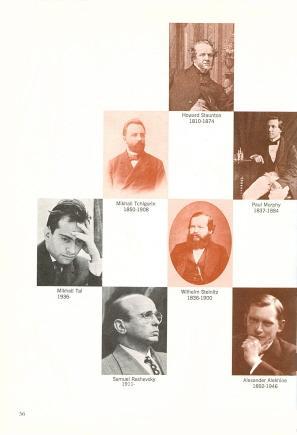
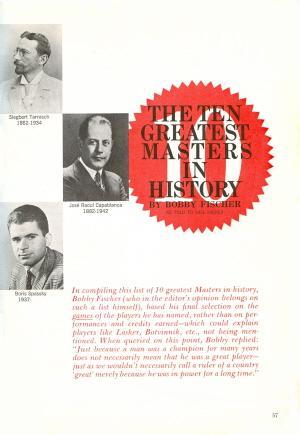
In C.N. 5998 Michael McDowell (Westcliff-on-sea, England) observed that the full Staunton photograph had been given on page 84 of The World of Chess by A. Saidy and N. Lessing (New York, 1974), credited to Lawson on page 248. We do not recall any pre-1964 source which gave the photograph either in full or in part.
Below is an extract from a letter to us from David Lawson dated 15 May 1979:
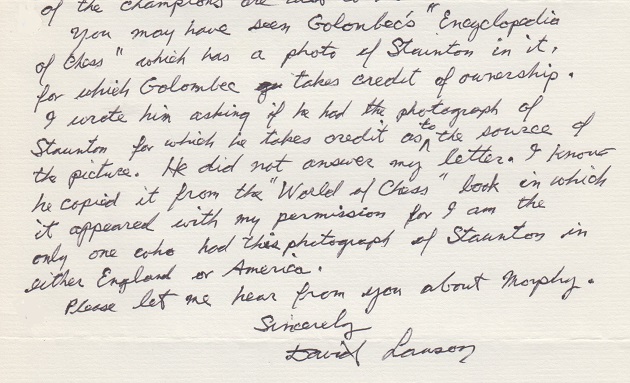
(10458)
From page 106 of The Art of Chess by Colleen Schafroth (New York, 2002):
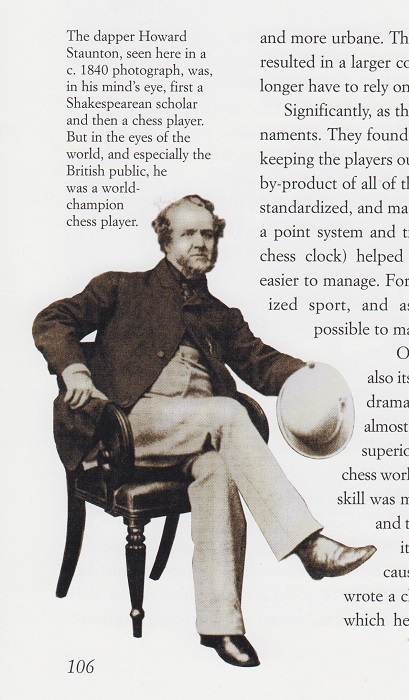
The discrepancy between the date ‘c. 1840’ and the word ‘photograph’ is evident. Information on the origins of the portrait is still being sought, but a possible clue is that the picture credit on page 171 of The Art of Chess states ‘John Jaques & Son, Ltd., London, England’.
(10524)
From John Townsend:
‘C.N. 10524 asks for information on the origins of the Staunton photograph. My 2011 book Notes on the life of Howard Staunton mentioned on page 170 that the Staunton portrait which accompanied Staunton’s obituary in the Illustrated London News of 4 July 1874 (i.e. Number Seven in Pictures of Howard Staunton) was engraved from a photograph by Messrs Rider and Preston, of Southampton.
If Gene Gnandt was correct in C.N. 5958 that Number Six in Pictures of Howard Staunton was the photograph used as the basis for the engraving in the obituary, it follows that Number Six was taken by Rider and Preston.
For reasons given on pages 138-139 and 170 of my book, it is very likely that the photograph which the Illustrated London News attributed to Rider and Preston was taken early in the 1860s in Southampton, where Staunton had photographic business with the Ordnance Survey, which employed Rider in its Photographic Department. It is uncertain whether the photograph was taken before or after Rider and Preston set up business in 1862 as “Photographers, Photozincographic and Photolithographic Printers”.’
(10528)
SEVEN:
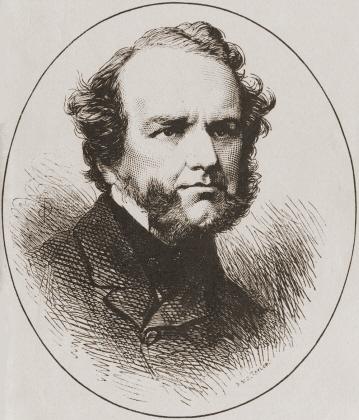
Gene Gnandt observed in C.N. 5958:
‘I believe that the photograph of Howard Staunton [see Six above] was used as a basis for an engraving by, if I read the initials correctly, P.M.E. Taylor. The engraving appeared in Staunton’s obituary in the Illustrated London News of 4 July 1874.’
EIGHT:
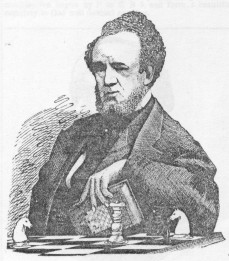
In C.N. 3397 (see pages 285-286 of Chess Facts and Fables) we mentioned that Samuel Loyd reproduced his sketches/woodcuts in the Scientific American Supplement, one per week during the column’s run from 11 August 1877 to 3 August 1878. The Staunton illustration above appeared on 6 October 1877 (page 1470), and Loyd wrote:
‘I have placed on the board a little five-move knight problem that I showed to him during my last visit to London. I dare say a microscopic observation would reveal the two-move position on the back of the book.’
We managed to identify the board position as a composition by
Loyd published on page 103 of the Chess Monthly, April 1858
(although the pieces are in the bottom left, and not bottom right,
corner):
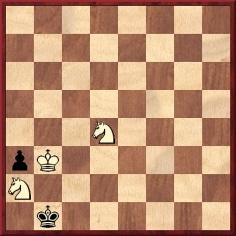
Mate in five: 1 Nc6 Ka1 2 Kc2 Kxa2 3 Nb4+ Ka1 4 Kc1 a2 5 Nc2.
C.N. 3745 reported our discovery of the picture on which the sketch by Loyd was evidently based:
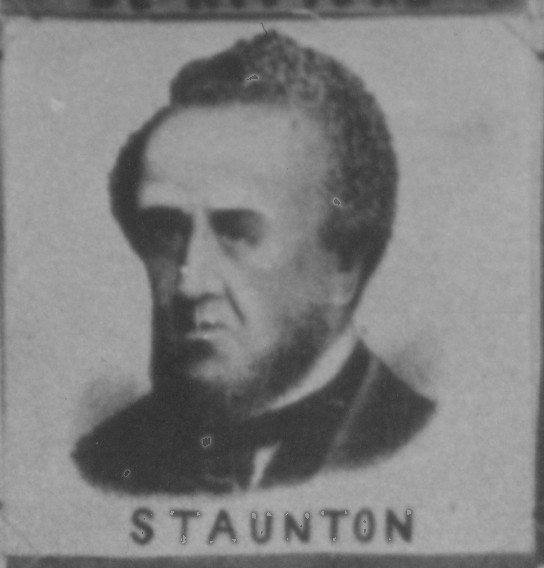
This comes from a 6x6 composite photograph of chess figures in our possession:
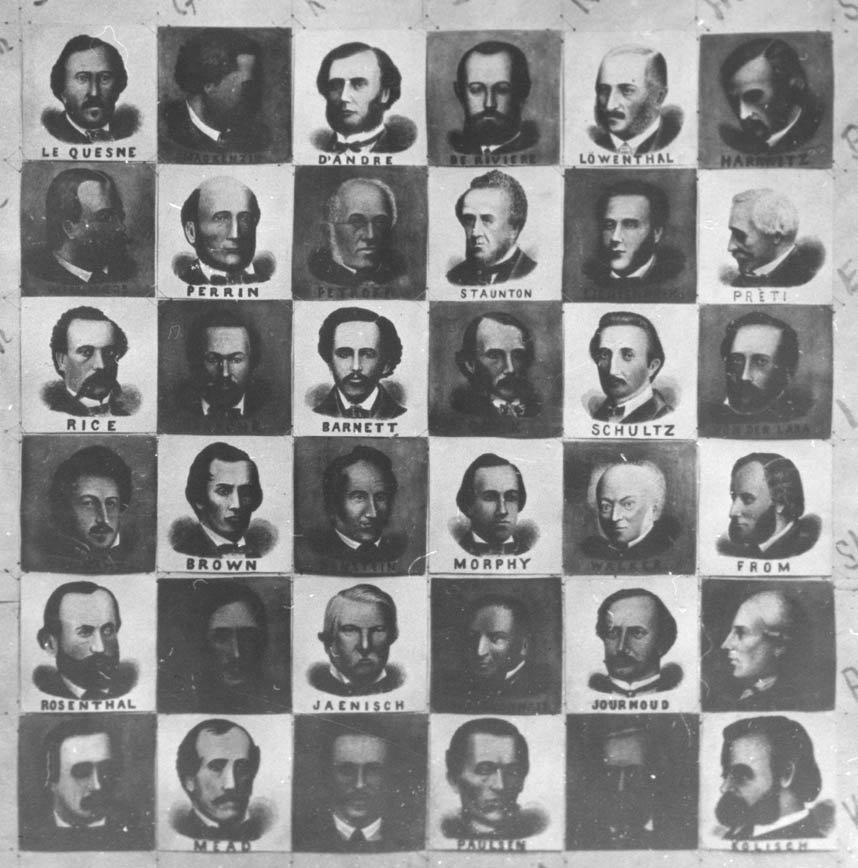
A larger version can be viewed by clicking here.
Can a better-quality copy of the Staunton picture, and some of the others, be found?
NINE:
C.N. 3451 gave the following portrait of Howard Staunton which had appeared, in very small format, on page 394 of the October 1911 issue of the Chess Amateur:
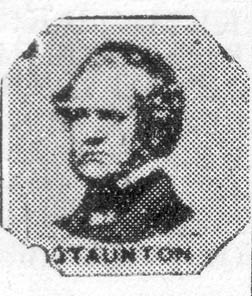
In C.N. 3467 Owen Hindle (Cromer, England) reported that it had featured in the ‘Champions of British Chess’ illustration on page 173 of the October 1898 American Chess Magazine:
For a larger version, click here.
Our correspondent also pointed out that in a feature on page 183 of the Chess Players’ Quarterly Chronicle, 1870 H. Meyer announced:
‘We have in view the publication of a Photographic Chess-board, containing (arranged on the squares) the portraits of 64 English composers. The Carte will be similar to the American Chess-board lately introduced to the chess community by Mr Loyd. ... We may also add a few chessplayers (not known as composers), whose portraits we have ... so as to complete the required number. A subscriber of half a crown will be entitled to a proof copy of the Cartes as soon as they are issued.’
Finally, Mr Hindle sent us a copy of I.O. Howard Taylor’s chess column in the Eastern Daily Press of 2 December 1871, which stated, ‘Mr Henry Meyer, the well-known problematist and chess editor, has brought out a Photographic Chess Board’. The chess personalia listed in the column’s description correspond to those in the above illustration.
A standard-size copy of the Staunton portrait remains to be found.
TEN:
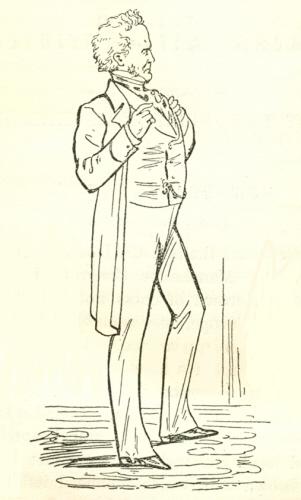
This sketch by Wallis Mackay was published on page 2 of Chess Life-Pictures by G.A. MacDonnell (London, 1883).
ELEVEN:
Michael McDowell asked in C.N. 5614 about the photograph referred to as follows at the website of the Lewis Carroll Society:
‘Chess-Players, August 1866
This photograph, in Album P(3) of the Morris L. Parrish collection in Princeton University, was kept by Lewis Carroll but probably not taken by him. Almost certainly it shows thirty of the contestants and guests at the Redcar chess congress that Lewis Carroll attended on 10 August 1866. Most have not been identified, but Cecil De Vere, the winner of the main tournament, is pictured (the tall young man left of centre standing with his arms folded). To his left in front, seated holding his top hat is Howard Staunton. Two chess problemists, Walter Grimshaw (in the centre at the back, just to the right of Howard Staunton) and Henry E. Kidson (standing to the left and behind the seated gentleman with a stick on the right) are also probably identifiable.
This photograph is reproduced in (Taylor, page 205).’
The website does not give the photograph, and in C.N. 5614 we were able to express gratitude to the Princeton University Press for permission to reproduce it, from the fine book referred to above, Lewis Carroll Photographer by Roger Taylor and Edward Wakeling (Princeton and Oxford, 2002):
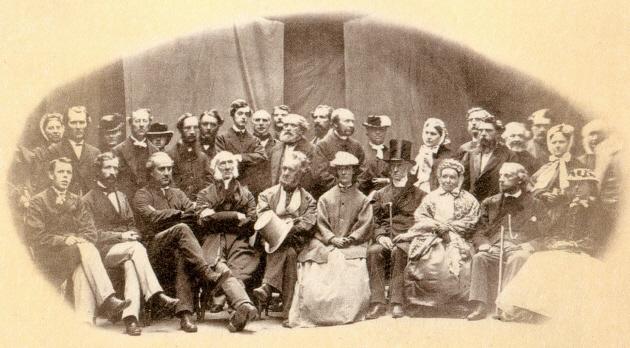
The caption reads as follows:
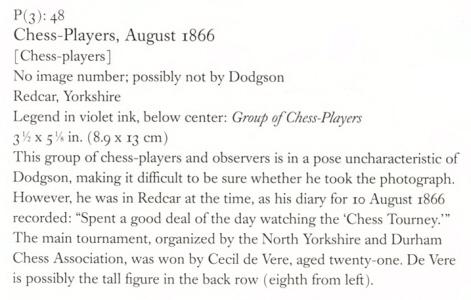
For a larger version of the photograph, click here. Below is a detail of Howard Staunton:
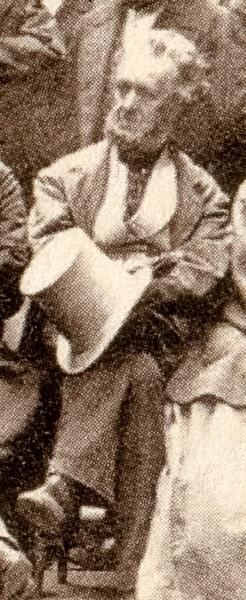
An account of the Redcar tournament appeared on pages 194-196 of the 1866 volume of Staunton’s periodical the Chess World. Organizational shortcomings were referred to (including ‘a want of liberality, a want of hospitality in the arrangements’), after which those in attendance were listed:
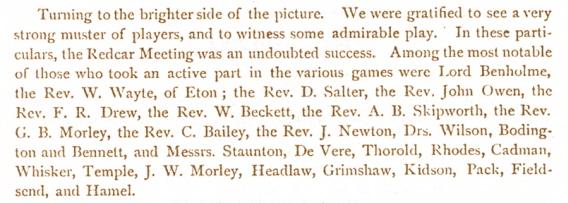
In the present article we have left aside caricatures of Staunton (see, for instance, page 151 of the September-October 1935 issue of Les Cahiers de l’Echiquier Français). The present compilation cannot, in any case, be complete. Tantalizing reports are occasionally found in chess literature, and one instance was quoted in C.N. 3995, from page 129 of the April 1930 BCM:
‘A very interesting meeting of the Executive Committee of the British Chess Federation was held in London, on 8 March. Major Sir Richard Barnett, who was in the chair, very kindly offered to purchase and present to the Federation an oil painting of Howard Staunton, dated 1846 ...’
This report was briefly mentioned in C.N. 1136 (see page 193 of Chess Explorations), but no further information about the portrait has come to our attention.
The above article originally appeared at ChessBase.com.
Further pictures:
TWELVE:
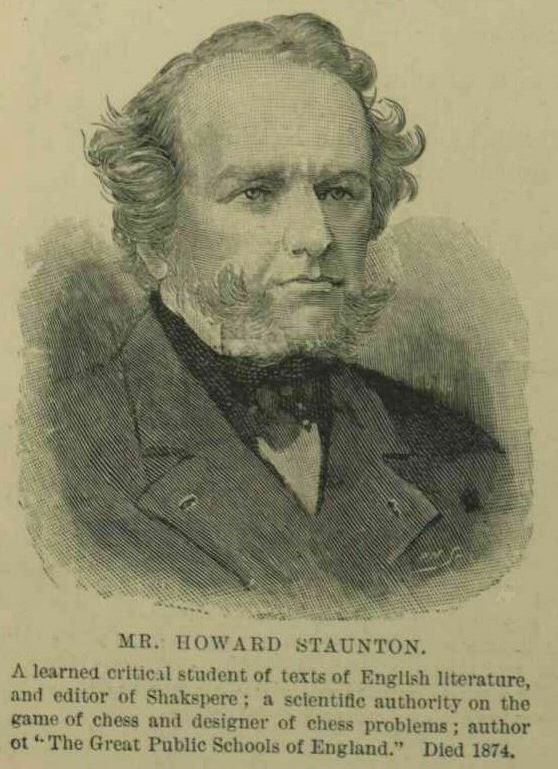
Source: Illustrated London News, 14 May 1892, page 598.
THIRTEEN:
Vitaliy Yurchenko (Uhta, Komi, Russian Federation) informs us that his collection of postage stamps includes the following:
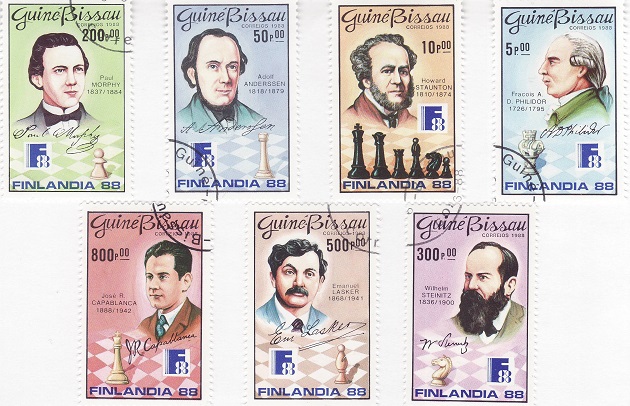
(9723)
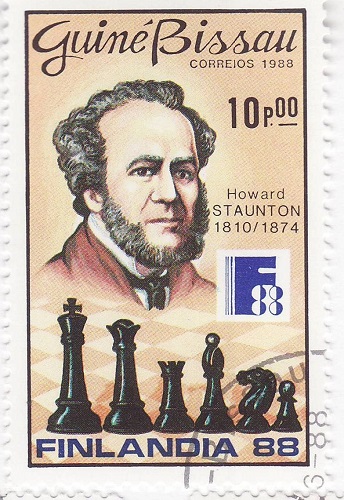

From Michael Clapham:
‘Regarding the monochrome picture of Staunton and Horwitz which you have reproduced in “Pictures of Howard Staunton” from Deutsches Wochenschach, 2 October 1910, I have a tinted copy with, pasted on the back, a small cutting from the Illustrated London News which specifies the date 7 February 1846:’
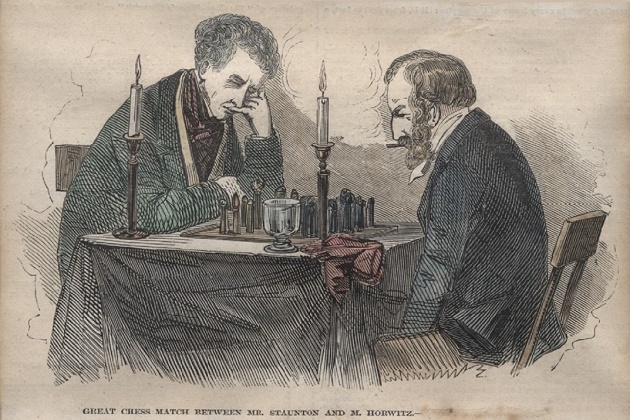
The picture was published on page 100 of that issue of the Illustrated London News, with a reference in the caption to Staunton’s chess column on page 99:
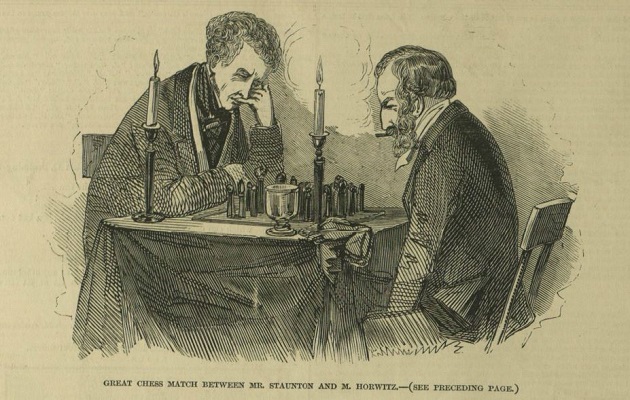
Another illustration (‘Four’) in the Staunton feature article was discussed in C.N.s 5998 and 6015. In the former item a correspondent suggested that the artist’s signature seemed to read ‘Maguille’, and in the latter we noted that the picture had appeared in the Chess Monthly in 1890.

Source: page 164 of A Century of British Chess by P.W. Sergeant (London, 1934)
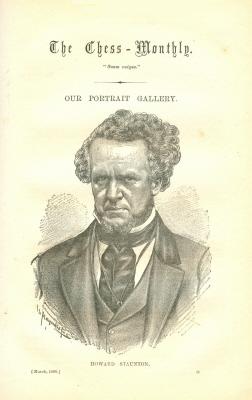
Source: page 193 of Chess Monthly, March 1890
‘Pictures of Howard Staunton’ also mentions that a similar sketch, by Alexander Forrest, was published on page 70 of The Chess-player’s Week-end Book by R.N. Coles (London, 1950):
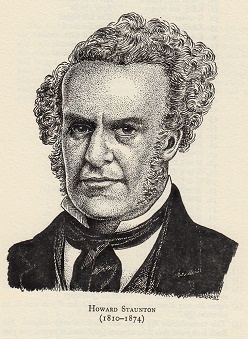
Coles’s book had illustrations by Forrest of 11 masters: Philidor, Labourdonnais, Anderssen, Lasker, Alekhine, Euwe, Botvinnik, Staunton, Steinitz, Capablanca and Morphy.
Mr Clapham now adds:
‘Although the sketch by Forrest is indeed very similar to the “Maguille” picture, there are significant differences, concerning the beard, sideburns, neck-ribbon and lapels. Variations in the eyes, eyebrows and lips give a different overall expression.
The “Maguille” picture is on page 170 of Howard Staunton Uncrowned Chess Champion of the World by Bryan M. Knight (Montreal, 1974) with the caption “Howard Staunton – circa 1840”.
The Forrest sketch is on the back of the dust-jacket of the Batsford reprint (London, 1985) of Staunton’s The Chess-Player’s Handbook. Elsewhere the dust-jacket states, without any mention of Forrest or Coles:
“The drawing of Howard Staunton on the back cover was produced [sic] by courtesy of Brian Reilly.”’
(8897)
Juan Carlos Sanz Menéndez (Madrid) points out that an illustration which is slightly different from numbers seven and twelve in Pictures of Howard Staunton appeared on page 479 of the Madrid publication La Ilustración Española y Americana, 15 August 1874. It is shown below, followed by the other two, which were given in the Illustrated London News in 1874 and 1892 respectively:
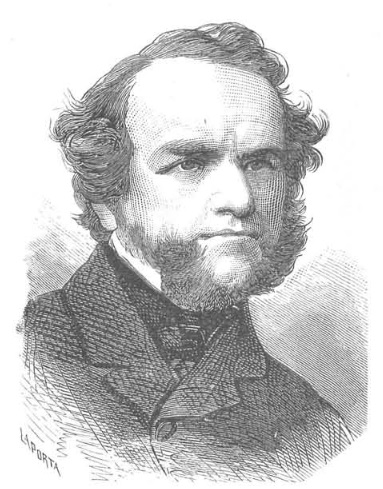
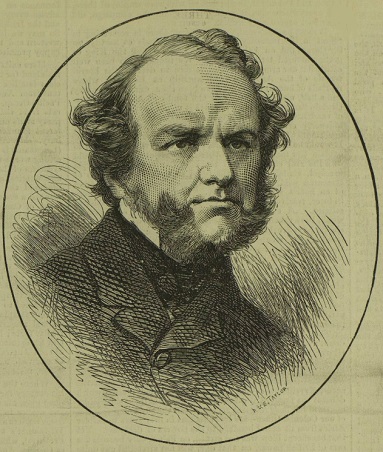
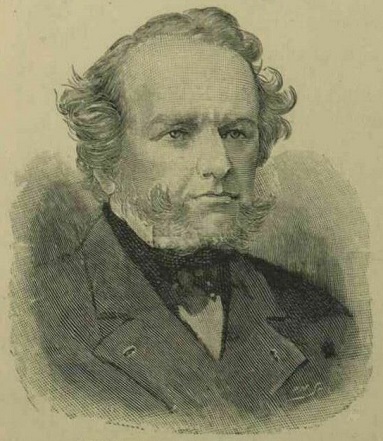
(8905)
As mentioned in C.N.s 1136 and 3995 (see above), page 129 of the April 1930 BCM referred to a Staunton painting on which details are lacking:

John Townsend writes:
‘Page 4 of the Cheltenham Chronicle of 15 February 1930 reported that the owner of the painting was C. Forsdick of 34 Jewry-street, Winchester and gave the following details:
“The size of painting is 12x10, and it is in a frame with an inscription on – ‘Howard Staunton Esq., Champion Chess Player, Painted by P. Westcott, 1846’.”
Later, The Times of 10 March 1930 (page 11) carried a report on the meeting of the Executive Committee of the British Chess Federation that was mentioned in C.N.s 1136 and 3995, and named the artist as Philip Westcott:
“It was announced that an oil painting of the late Howard Staunton, by Philip Westcott, had been offered to the Federation, and that Sir Richard Barnett had arranged to purchase it and present it to the Federation.”
Philip Westcott was a portrait painter, born about 1815 in Liverpool, where he is to be found at the time of the 1841 and 1851 censuses.
Sir Richard Barnett died later in 1930, his obituary appearing in The Times of 18 October, page 14.
Is any information available from BCF records that confirms that the presentation took place and identifies the person to whom custody of the painting was entrusted?’
(9287)
From page 21 of Kings of the Chessboard by Paul van der Sterren (Landegem, 2019):
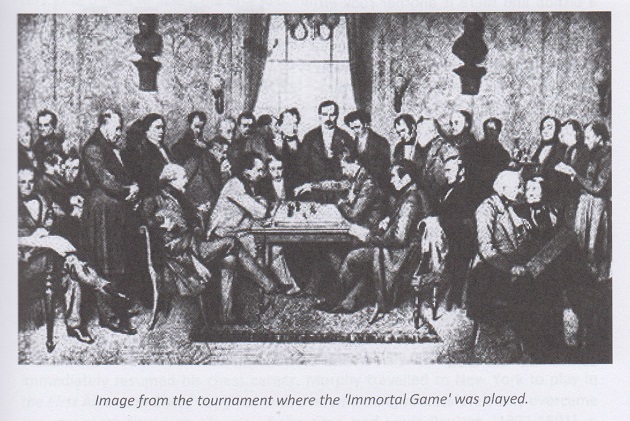
(11443)
John Townsend writes:
‘Regarding claims that Staunton’s 1843 victory over Saint-Amant in Paris was commemorated with a bronze medallion associated with St George’s Chess Club, page 157 of my 2011 book Notes on the Life of Howard Staunton mentioned a life-size medallion of Staunton’s head which had been “cleverly” modelled by an Italian sculptor “some years ago”. In 1873 Staunton ordered further casts to be made and sent two of them to his fellow Shakespeare editors, James Orchard Halliwell-Phillipps and Horace Howard Furness, an American.
The following passage on pages 133-134 of C.A. Gilberg’s book on New York, 1880 has just come to my attention:
“Facing the entrance to the hall our own national emblem bore within its massive folds the name of Paul Morphy, while, vis-à-vis, a large medallion bust in alto relievo of the late Howard Staunton was appropriately surrounded with the flags of Great Britain.”
Can any further information about the Staunton medallion bust be found, and are images of any Staunton medallions known?’
We can add, courtesy of the Cleveland Public Library, the back cover of the September 1853 Chess Player's Chronicle:
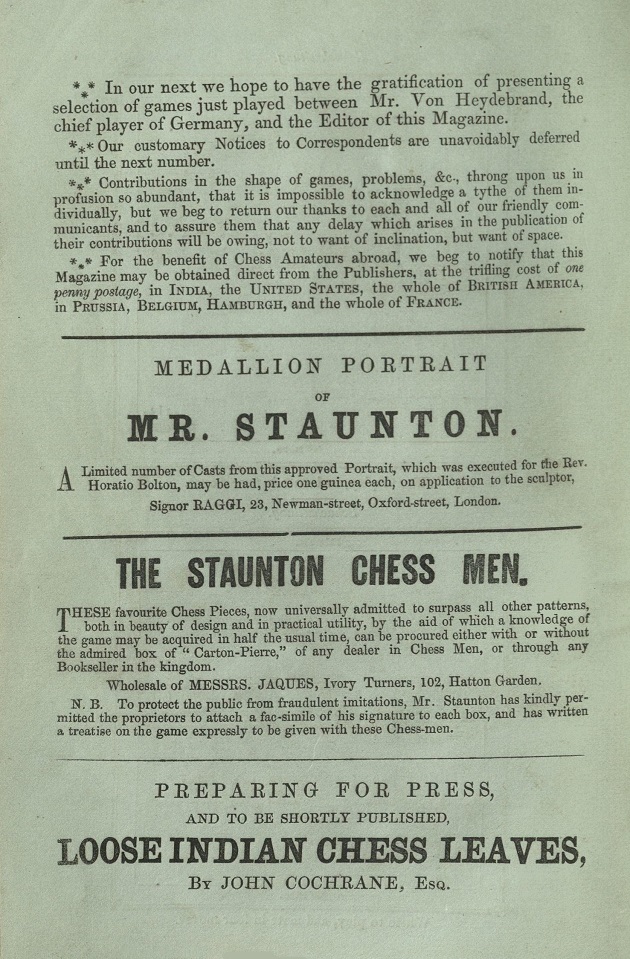
(11524)
See also the small sketch of Staunton in C.N. 11219, on page 4 of the Argentine newspaper Crítica, 29 November 1927.
To the Chess Notes main page.
To the Archives for other feature articles.
Copyright: Edward Winter. All rights reserved.